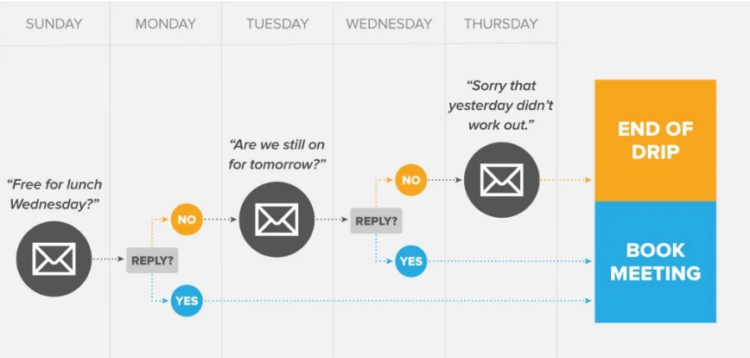There are lots of different types of email marketing campaigns that you can automate. And as a good rule of thumb, when you can automate, you should automate.
Doing so will save you time and energy. It will also make your email marketing efforts far more effective and efficient.
So, here are some types of email campaigns and functions that you should definitely automate…
- Drip sequence — Many email marketers use drip sequences to stay in consistent contact with their subscribers, take each subscriber on a journey from point A to point B, offer discounts, prospect, and make sales. In most cases, when a new subscriber signs up, they’re put into a drip sequence that can last anywhere from 10 days to an entire year, depending on the company sending the emails, their offer, and how long they want the sequence to last. And it’s no wonder that email marketers love drip sequences. Open rates on drip campaigns are 80% higher than broadcast emails and click-through rate is three times higher. But this is definitely an email campaign you’ll want to automate.

- Triggered emails — Triggered emails are a massively important part of your subscriber’s experience and they’re an important tool for making more sales and getting more conversions. Triggered emails can convince a cart-abandoner to finish their purchase, re-engage a subscriber who hasn’t opened your emails for a long while, welcome new subscribers, onboard new customers, and make old subscribers feel special (by sending birthday emails, for example). You definitely want to automate these kinds of email campaigns because they can’t be sent manually.

- Segmentation & Tags — This is more of a function of your email marketing efforts than it is an “email campaign.” But automating your segmentation and tagging process is absolutely vital if you plan to grow your email list any higher than 100 subscribers. The last thing you want, after all, is to have to manually tag each and every subscriber based on their interest, location, gender, age, sign-up incentive, or other differentiating factors… no. Automate. One great way to automate your segmentation and tagging process is to send a short survey as a part of the subscriber’s onboarding process that communicates directly with your ESP, putting the subscriber right where they belong.
- Workflows — You should also automate your internal workflows for emailing. Everything can get much more complicated than it needs to be really quickly if you don’t have clear-cut systems for when to email, who to email, and how to email. Consider signing up for a CRM or project management software that can help you organize your email list, habits, standards, and expectations.
- Dynamic Lists — Your subscribers are people, not robots. And people change from day to day, week to week, and month to month. People are dynamic and so, too, many email marketers argue, should be your email lists. While a static email list segments subscribers into groups and never divides them again, unless you manually do so, a dynamic list is constantly adapting to each subscriber’s behaviors and putting them in the group, tag, or segmentation that most fits their current actions (people’s actions speak a lot louder than their words, after all, so this type of segmentation is often much more accurate than sending a survey). Most dynamic email software pays close attention to each subscriber’s individual open rate, click-through rate, conversion rate, and other pertinent website engagement metrics. Then, the dynamic list software puts each subscriber where they belong… for the time being. This often means much higher engagement from your subscribers and more conversions and sales.
- You can learn more about this over here.
- Personalization — Many email marketing studies and research suggest that personalization (adding a subscriber’s name or interests or personalized recommendations to an email) will increase engagement metrics. It’s no surprise then, that 74% of marketers believe targeted personalization increases customer engagement. But every list is different. You don’t want to over-use personalization or subscribers might feel like you’re tricking them, like your brand is being fake. You also probably don’t want to avoid personalization altogether, or subscribers might feel like your brand is impersonal. It’s a balance. Use some personalization for your email list — add the subscriber’s name or gender, or some personalized recommendations and see how it goes. The first priority is the relationship you’re building. Everything else is secondary. Just make sure that you automate your personalization process using your ESP so you don’t have to try and do it manually.
- Testing — As much as you can, you should automate the testing process for your email marketing campaigns. The more automated and easy-to-follow your testing procedures are, the more often you’ll test, iterate, and the better emails you’ll send. Most high-quality ESPs will allow you to create A/B tests and run them as long as you like. You can (and should) apply consistent A/B tests to your drip sequences and your triggered emails, and you should also have a defined and clear process and cadence for testing your email campaigns. Remember, the easier you make it to test, the more you’re going to do it, and the better results you’re going to get.
Note: There are only a few types of emails that you shouldn’t automate. These are the ones that you send off-the-cuff. Broadcasts, newsletters, or updates are all examples of email campaigns which can’t be easily automated (and probably should be sent manually).
